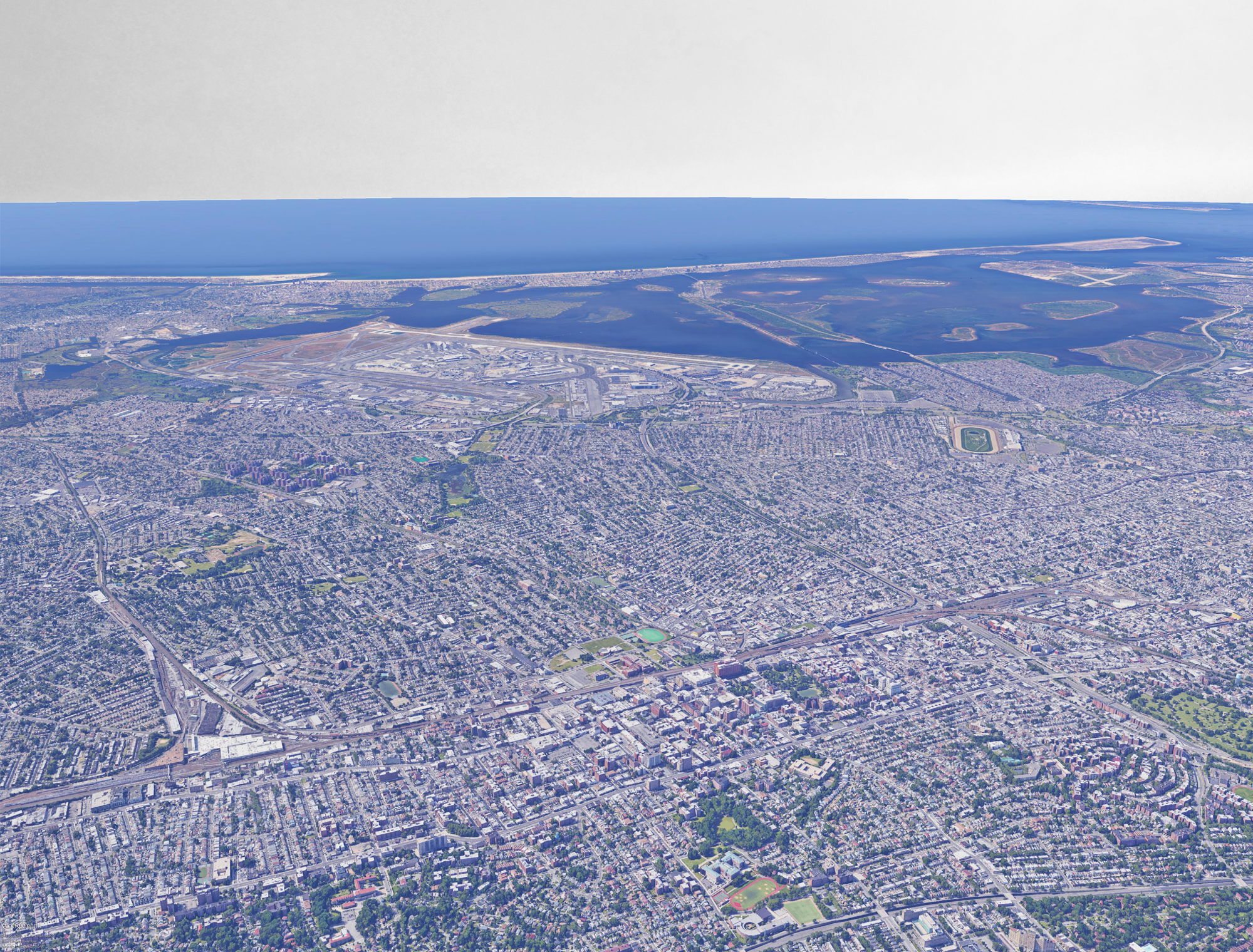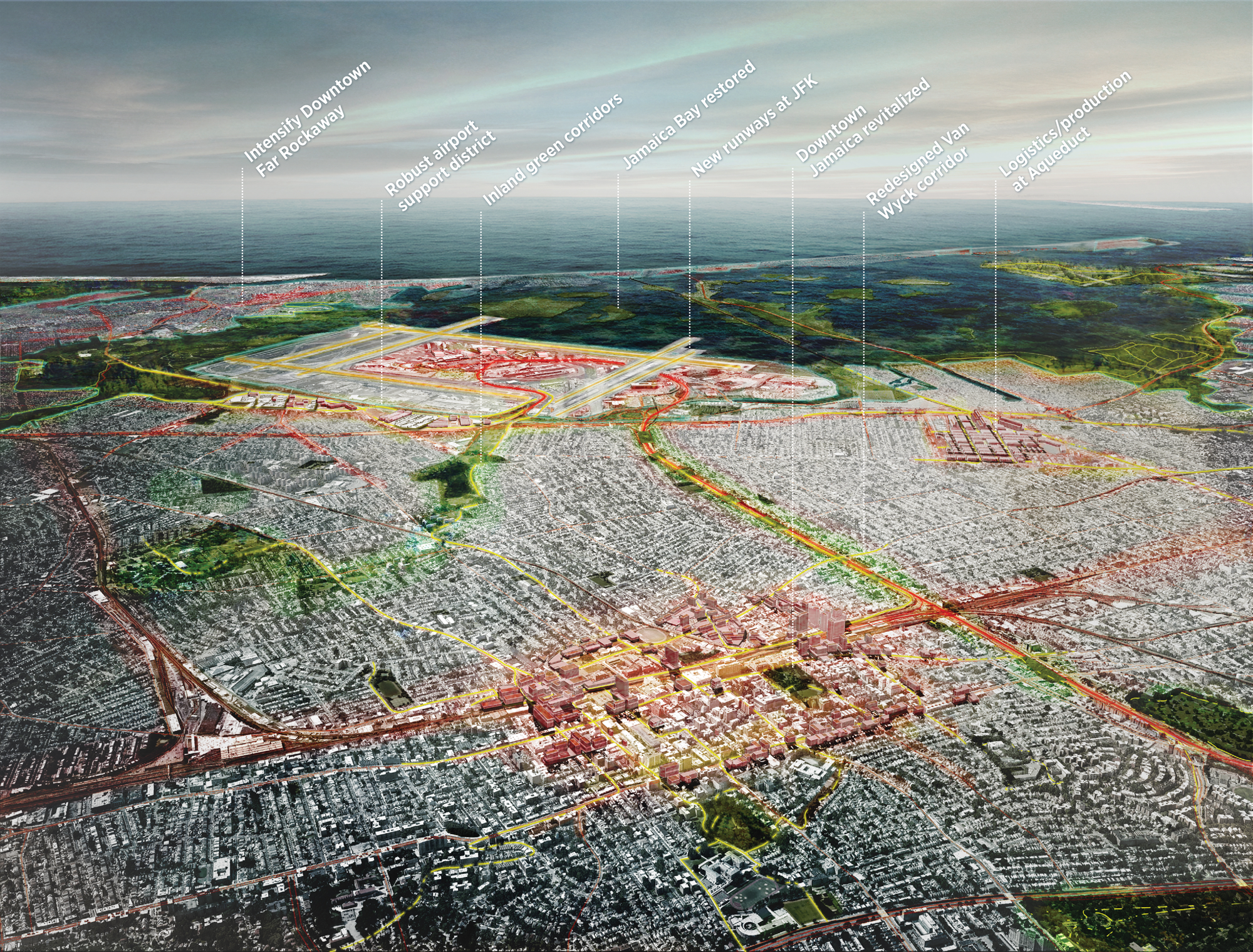


As a regional downtown, Jamaica has much to offer. It is a cultural hub with theaters and dining options as well as shopping that attracts residents and visitors from both the region and around the world. Traveling on the Long Island Rail Road (LIRR) from Jamaica to downtown Brooklyn is fast and easy with a new regional rail service that helps many city employees get to work. New hotels attract international travelers from JFK, who prefer Jamaica’s reasonable rates to those of the more expensive Manhattan. During the day, local restaurants serve food from all over the globe to the many people who work nearby, including airport workers and employees of light-manufacturing businesses.
New terminals and runways at JFK allow the facility to handle nearly twice as many people—59 million passengers in 2016—and more goods than ever before coming through the airport. Thousands of back-office airline jobs, concessions, and other aviation-related or -dependent workers have offices in Jamaica, a short walk from Social Security Administration offices and civil courts in the area. There has been redevelopment in industrial areas outside the airport perimeter, and the former Aqueduct Racetrack has been redeveloped as a state-of-the-art goods-distribution hub with light industry, leveraging JFK’s role as a global gateway. Redesigned downtown streets have bike lanes and pedestrian greenways, while new pedestrian connections and activities link the north and south sides of the Long Island viaduct. Jamaica has maintained its diversity and social cohesion through anti-displacement measures, and its affordability by focusing larger-scale developments around the train station and selected major streets, with smaller, residential buildings on local streets.
The community remains largely non-white, and truly mixed-income, with new employment offering local residents additional job opportunities.


Jamaica has always had a number of advantages. It is located at the nexus of rich rail transportation infrastructure and the New York region’s largest airport, as well as long-term anchor institutions like York College. Strong community-development organizations, arts-related festivals and performances, and the multi‐cultural Jamaica Market add to the unique character and street life of the area.
But for years, downtown Jamaica lagged with respect to key equity indicators. There was a need to lift the overall quality of life by creating better jobs for its residents, increasing the availability of affordable housing, and improving traffic and congestion.
Reversing years of limited growth, Jamaica started to see an uptick in development at the turn of the century. By 2017, more than $1 billion in public and private investments had been made. Led by the Greater Jamaica Development Corporation and partners, a mix of city and state agencies and nonprofit planning groups dedicated resources to help revitalize the area. These included the Jamaica NOW Action Plan, Regional Plan Association’s Downtown Jamaica: Gateway to the New York Region, and New York State’s $10 million economic development investment in 2016. Anti-displacement protections, including anti-harassment protections for residents and small businesses put in place soon after, protected the most vulnerable lower-income households, while more mixed-income housing was constructed.
New offices and hotels opened, and then complemented by a wide range of retail establishments and restaurants, primarily located along Jamaica Avenue and Sutphin Boulevard, and above the subway stations. The area near the AirTrain station started to become a thriving mixed commercial and office district, and more airport-related office jobs came to buildings nearby. An extension of the LaGuardia Airtrain from Flushing Meadows down the Van Wyck to Jamaica was considered, in order to connect it to the new airport-related hub as well as provide a direct link between the two airports. The 165 Street bus terminal was redesigned as a modern mixed-use multi-modal facility with subterranean connections to the E, F, J, and Z subway lines. Downtown Jamaica built on its strong cultural foundation as home to the Jamaica Center for Arts and Learning, King Manor Museum, the Central Library of the Queens Library system, and the Jamaica YMCA to attract new arts-related festivals and events.
The MTA’s transformation of its commuter rail lines into a more integrated and affordable regional rail system greatly improved access between Jamaica and all major employment centers and communities in southeast Queens. The opening of East Side Access provided a direct connection to Grand Central Terminal via commuter rail, and new one-seat ride transit service connected JFK to downtown Brooklyn and all major destinations in Manhattan. This new service, the Trans-Regional Express, made JFK accessible from all corners of the region. The hotel at the TWA Terminal became popular with New Yorkers and visitors alike, providing conference and event space. The airport was hardened to address sea-level rise and storm surges, just as other airports in the region addressed the effects of climate change.
Regional downtowns in the tri-state area can be developed until they thrive, provide good jobs and affordable communities with policies that promote mixed-use development near transit services, maintain neighborhood diversity, and improve the overall quality of life with safe streets and green spaces. An inclusive planning process takes time, but helps craft a vision that has strong local and regional support. New regional rail networks can create better connections to more job opportunities, and areas around airports can help support airport growth while serving as destinations themselves.
Jamaica has always had a number of advantages. It is located at the nexus of rich rail transportation infrastructure and the New York region’s largest airport, as well as long-term anchor institutions like York College. Strong community development organizations, arts related festivals, performances, and the multi‐cultural Jamaica Market added to the unique character and street life of the area.
But for years Downtown Jamaica lagged with respect to key equity indicators. There was a need to lift the overall quality of life by creating better jobs for its residents, increasing the availability of affordable housing, and improving traffic and congestion.
Reversing years of limited growth, Jamaica started to see an uptick in development at the turn of the century. By 2017, more than $1 billion in public and private investments had been made. Led by the Greater Jamaica Development Corporation and partners, a mix of city and state agencies and non-profit planning groups dedicated resources to help revitalize the area. These included the Jamaica NOW Action Plan, Regional Plan Association’s Downtown Jamaica: Gateway to the New York Region, and New York State’s $10 million economic development investment in 2016. Anti-displacement protections including anti-harassment protections for residents and small businesses put in place soon after protected the most vulnerable lower-income households and more mixed-income housing was constructed.
New offices and hotels opened. These facilities were complemented by a wide range of retail establishments and restaurants, primarily located along Jamaica Avenue and Sutphin Boulevard, and above the subway stations. The area near the AirTrain station started to become a thriving mixed commercial and office district, and more airport related office jobs came to buildings nearby. An extension of the LaGuardia Airtrain from Flushing Meadows down the Van Wyck to Jamaica was being considered, in order to connect it to the new airport-related hub as well as provide a direct link between the two airports. The 165 Street bus terminal was redesigned as a modern mixed-use multi-modal facility with subterranean connections to the E, F, J and Z subway lines. Downtown Jamaica built on its strong cultural foundation as home to the Jamaica Center for Arts and Learning, King Manor Museum, the Central Library of the Queens Library system, and the Jamaica YMCA to attract new arts-related festivals and events.
The MTA’s transformation of its commuter rail lines into a more integrated and affordable regional rail system greatly improved access between Jamaica and all major employment centers and communities in southeast Queens. The opening of East Side Access provided a direct connection to Grand Central Terminal via commuter rail, and new one-seat ride transit service connected JFK to Downtown Brooklyn and all major destinations in Manhattan. This new service, the Trans-Regional Express, made JFK accessible from all corners of the region. The hotel at the TWA Terminal became popular with New Yorkers and visitors alike , and provides conference and event space. The airport was hardened to address sea level rise and storm surge as other airports in the region address the effects of climate change.
Regional downtowns in the tri-state area can be developed, thrive and provide good jobs and affordable communities with policies that promote mixed-use development near transit services, maintain neighborhood diversity and improve the overall quality of life with safe streets and green spaces. Leveraging its links to nearby JFK and a redeveloped Aqueduct Race Track, Jamaica’s economy evolved in tandem with the airport’s growth, offering new jobs and opportunity, and the race track took on new life as a light industry and distribution hub.
An inclusive planning process helped craft a vision for the area that took time, but expedited the kind of development that local leaders and communities wanted and the region supported.